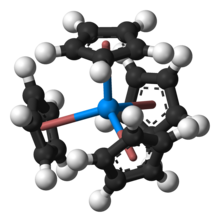Tetrakis(cyclopentadienyl)uranium(IV)
Appearance

| |
| Names | |
|---|---|
| IUPAC name
Tetrakis(η5-cyclopentadienyl)uranium(IV)
| |
| Other names
Tetracyclopentadienyluranium
U(Cp)4 | |
| Identifiers | |
3D model (JSmol)
|
|
| ChemSpider | |
PubChem CID
|
|
| |
| |
| Properties | |
| C20H20U | |
| Appearance | red crystals |
Except where otherwise noted, data are given for materials in their standard state (at 25 °C [77 °F], 100 kPa).
| |
Tetrakis(cyclopentadienyl)uranium(IV), U(C5H5)4, abbreviated U(Cp)4, is an organouranium compound composed of a uranium atom sandwiched between four cyclopentadienide rings.
Synthesis and properties
[edit]Tetrakis(cyclopentadienyl)uranium(IV) was first prepared in 1962 by Ernst Otto Fischer, who reacted uranium tetrachloride with excess potassium cyclopentadienide in benzene and obtained the complex as red crystals at 6% yield:[1][2]
- UCl4 + 4 KCp → U(Cp)4 + 4 KCl
Solid crystals of U(Cp)4 are air-stable, but the benzene solution is extremely air-sensitive.
Reduction of U(Cp)4 with uranium metal yields tris(cyclopentadienyl)uranium(III), U(Cp)3.[1]
References
[edit]- ^ a b Seyferth, Dietmar (2004-07-01). "Uranocene. The First Member of a New Class of Organometallic Derivatives of the f Elements". Organometallics. 23 (15): 3562–3583. doi:10.1021/om0400705. ISSN 0276-7333.
- ^ Fischer, Ernst Otto; Hristidu, Yani (1962-04-01). "Notizen: Über Aromatenkomplexe von Metallen LVII. Uran-tetracyclopentadienyl". Zeitschrift für Naturforschung B. 17 (4): 275–276. doi:10.1515/znb-1962-0410. ISSN 1865-7117. S2CID 105017911.
Wikimedia Commons has media related to Tetrakis(cyclopentadienyl)uranium(IV).
